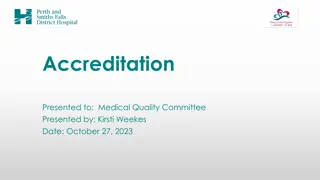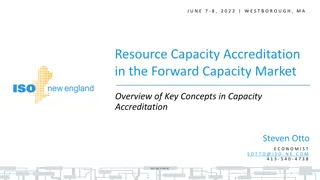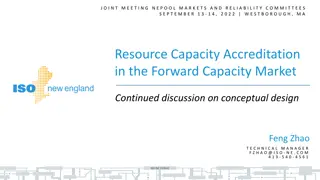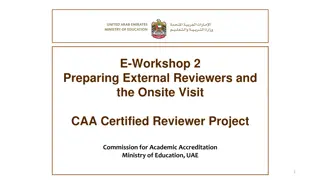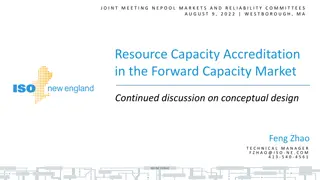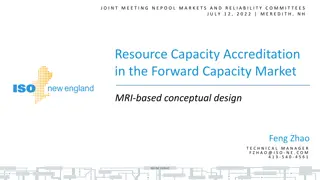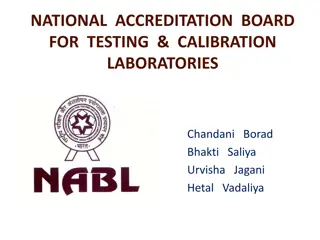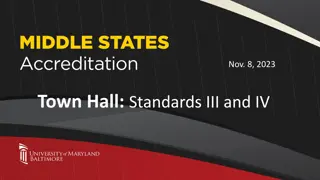Resource Capacity Accreditation in Forward Capacity Market Discussion
The Resource Capacity Accreditation project by ISO-NE aims to enhance accreditation processes in the Forward Capacity Market. This presentation reviews key concepts, including nomenclature, Marginal vs. Average approaches, and follow-up items from previous meetings. It emphasizes the commitment to a reliable, clean-energy transition through improved methodologies for resource contribution accreditation.
Download Presentation

Please find below an Image/Link to download the presentation.
The content on the website is provided AS IS for your information and personal use only. It may not be sold, licensed, or shared on other websites without obtaining consent from the author.If you encounter any issues during the download, it is possible that the publisher has removed the file from their server.
You are allowed to download the files provided on this website for personal or commercial use, subject to the condition that they are used lawfully. All files are the property of their respective owners.
The content on the website is provided AS IS for your information and personal use only. It may not be sold, licensed, or shared on other websites without obtaining consent from the author.
E N D
Presentation Transcript
J U L Y 1 2 - 1 4 , 2 0 2 2 | M E R E D I T H , N H Resource Capacity Accreditation in the Forward Capacity Market Continued Discussion on Average and Marginal Approaches Feng Zhao T E C H N I C A L M A N A G E R F Z H A O @ I S O - N E . C O M 4 1 3 - 5 4 0 - 4 5 6 1 ISO-NE PUBLIC
WMPP ID: 157 Resource Capacity Accreditation in the Forward Capacity Market Proposed Effective Date: FCA 19 The Resource Capacity Accreditation (RCA) project proposes improvements to ISO-NE s accreditation processes in the Forward Capacity Market (FCM) to further support a reliable, clean-energy transition by implementing methodologies that will more appropriately accredit resource contributions to resource adequacy as the resource mix transforms The ISO has made a commitment to FERC to file proposed improvements in time for FCA 19 This presentation continues discussion of key concepts in capacity accreditation and addresses several follow-up items from the June MC/RC meeting ISO-NE PUBLIC 2
WMPP ID: 157 Resource Capacity Accreditation in the Forward Capacity Market Proposed Effective Date: FCA 19 This presentation will focus on: Review of nomenclature (slides 5-6) Continued discussion of Marginal vs. Average (slides 8-26) Additional questions on Marginal vs. Average (slides 28-30) Follow-up items from June meeting (slides 32-34) Conclusion (slide 36) ISO-NE PUBLIC 3
NOMENCLATURE ISO-NE PUBLIC ISO-NE PUBLIC 4
Nomenclature At the June Joint MC/RC meeting, common nomenclature was presented to help with discussing accreditation concepts and approaches going forward Based on stakeholder feedback, an additional term for Class has been added to the list below: Accredited capacity measures a resource s estimated reliability contribution and is used to determine the maximum amount of capacity a resource can sell in a forward reliability/capacity market Qualified capacity ISO-NE s current approach to accrediting resources using a combination of ICAP and heuristic approaches Substitutability resources are substitutable if small changes in the accredited capacity of different resources have approximately the same impact on resource adequacy Marginal approach accredits resources based on their marginal contribution to reliability Continued on the next slide ISO-NE PUBLIC 5
Nomenclature, cont. Average approach accredits resources based on their share of their class total contribution to system reliability Class a set of resources with similar technology, location, etc. Class average ELCC approach an average approach that examines the impact on a given reliability metric of the addition or removal of an entire class Marginal ELCC approach a marginal version of the average ELCC approach that examines the impact on a given reliability metric of the addition or removal of a small increment of a given resource MRI approach a marginal approach that accredits resources based on the impact an incremental increase in a resource s capacity has on resource adequacy ISO-NE PUBLIC 6
CONCEPTUAL MARGINAL VS. AVERAGE APPROACH EXAMPLE ISO-NE PUBLIC ISO-NE PUBLIC 7
Example Roadmap At the June MC meeting, stakeholders noted it would be helpful to have further discussion on the conceptual marginal and average approach example This section will walk through a more detailed version of the graphical example from June materials The section begins by demonstrating the calculation of marginal accreditation value for our blue dot resource with regards to perfect capacity Next, the section demonstrates the calculation of average accreditation value for the blue dot resource with regards to perfect capacity Finally, the section considers a second resource class that has the same total contribution to reliability as the first resource class, but a smaller marginal contribution to reliability ISO-NE PUBLIC 8
Example Roadmap: Marginal Approach to Accreditation First, we will examine how a marginal accreditation value is calculated using perfect capacity To do so, the example introduces a new line segment: perfect capacity s marginal contribution to reliability To calculate the blue dot resource s accredited capacity with a marginal approach, we will multiply its capacity by the ratio of its marginal contribution to reliability to perfect capacity s marginal contribution to reliability For convenience, we will refer to the blue dot resource as being in Resource Class 1 ISO-NE PUBLIC 9
Graphical Demonstration of Marginal Approach This figure shows the marginal reliability contribution of Resource Class 1 at different penetration levels of that class 10 Contribution (hours/year) Marginal Reliability Illustrates EUE as the relevant reliability measure, where the marginal reliability contribution is measured by the MWh decrease in EUE given a 1 MW increase in the Resource Class 1 s penetration The unit for marginal reliability contribution is MWh/year/MW, or hours/year, as with the capacity demand curves 7 4 1,000 500 Capacity (MW) Continued on the next slide ISO-NE PUBLIC 10
Graphical Demonstration of Marginal Approach, cont. Suppose there are 999 MWs of Resource Class 1 in the mix and the region is considering the addition of a 1 MW resource in the class, represented by the blue dot 10 Contribution (hours/year) Marginal Reliability 7 4 1,000 500 Capacity (MW) Continued on the next slide ISO-NE PUBLIC 11
Graphical Demonstration of Marginal Approach, cont. The marginal reliability contribution of the potential new resource is the height of the marginal reliability contribution line at Resource Class 1 s penetration, assuming the new resource is built Conceptually, marginal approaches accredit all resources using this marginal reliability contribution E.g., the resource represented by the blue dot would be accredited based on the 4 hours/year value ISO-NE PUBLIC 12
Marginal Contribution of Perfect Capacity To calculate an accreditation value for the blue dot resource using a marginal approach, we need to compare its marginal contribution to reliability to the reference, i.e., perfect capacity s marginal contribution to reliability ISO-NE PUBLIC 13
Marginal Contribution to Perfect Capacity, cont. Assume the same resource mix that includes Resource Class 1 also has 199 MW of perfect capacity Contribution (hours/year) Marginal Reliability 20 The marginal contribution of perfect capacity is given by the height of its marginal reliability contribution line segment at 200 MW, denoted by the green dot In this case, perfect capacity s marginal reliability contribution is 20 hours/year 200 Capacity (MW) ISO-NE PUBLIC 14
Calculating Capacity Accreditation with Marginal Approach The blue dot resource s accreditation value is its capacity (1 MW) times its relative marginal reliability contribution, which is 4 hours/year divided by perfect capacity s marginal contribution of 20 hours/year 4 ???? ???? 20 ???? ???? Accredited Capacity with Marginal Approach = 1 ?? = 0.2 ?? Note that accrediting the blue dot resource (and the rest of Resource Class 1) in this way results in accredited capacity for Resource Class 1 that is substitutable with perfect capacity: increasing the accredited capacity of Resource Class 1 by 1 MW (or equivalently by 5 MW of Class 1 s capacity) has the same impact on EUE as increasing perfect capacity by 1 MW 5 MW * 4 hours/year = 1 MW * 20 hours/year ISO-NE PUBLIC 15
Example Roadmap: Average Approach to Accreditation Next, we examine how an average accreditation value is calculated using perfect capacity as reference To do so, the example uses the same line segment for perfect capacity as above To calculate the blue dot resource s accredited capacity with an average approach, we will multiply its capacity by the ratio of i) the quantity of perfect capacity the system would need to add to keep EUE constant when Resource Class 1 is removed from the mix, to ii) the penetration of Resource Class 1 ISO-NE PUBLIC 16
Graphical Demonstration of Average Approach The shaded area under the marginal reliability contribution curve up to and including the blue dot represents the total reliability contribution of Resource Class 1, assuming the new resource is built This area is measured in MWh of decreased EUE, and equals 7,000 MWh 10 Contribution (hours/year) Marginal Reliability 7 4 1,000 500 Capacity (MW) Continued on the next slide ISO-NE PUBLIC 17
Calculating Capacity Accreditation with an Average Approach To calculate the accreditation value for the blue dot resource under an average approach, we need to: 1) find the quantity of perfect capacity we would need to add to the mix to get the same total reliability contribution (7,000 MWh) 2) then compare this quantity of perfect capacity added with Resource Class 1 s penetration (1,000 MW) ISO-NE PUBLIC 18
Quantity of Perfect Capacity Needed to Replace Resource Class 1 The red shaded trapezoid below has an area = 7,000 MWh and measures the reduction in expected unserved energy that results from adding 400 MW of perfect capacity to the mix An additional 400 MW of perfect capacity in the mix provides the same total contribution to reliability as Resource Class 1 (7,000 MWh) Contribution (hours/year) Marginal Reliability 20 15 600 200 Capacity (MW) ISO-NE PUBLIC 19
Calculating Capacity Accreditation with an Average Approach The blue dot resource s average accreditation value is its capacity (1 MW) times the ratio of the quantity of perfect capacity added to the penetration of Resource Class 1: Accredited Capacity with Average Approach = 1 ?? 400 ?? 1000 ??= 0.4 ?? Note that accrediting the blue dot resource in this way does not result in accredited capacity for Resource Class 1 that is substitutable with perfect capacity: adding 1 MW of accredited capacity from Resource Class 1 (or equivalently 2.5 MW of Class 1 capacity) does not yield the same change in EUE as adding 1 MW of perfect capacity 2.5 MW * 4 hours/year 1 MW * 20 hours/year ISO-NE PUBLIC 20
Example Roadmap: Cost-Effectiveness and Marginal vs. Average Finally, to compare the extent to which the marginal and average approaches are cost-effective, we introduce a second resource class, Resource Class 2 The example will show that Resource Class 2 has the same total reliability contribution as Resource Class 1 but a smaller marginal reliability contribution The system is considering the addition of a 1 MW purple dot resource to Resource Class 2 and the example calculates the marginal and average accreditation values for this resource The example will consider which resource should clear and which resource would clear under the different approaches ISO-NE PUBLIC 21
Purple Dot Resources Marginal Accreditation Value This figure displays Resource Class 2 s marginal contribution to reliability 12 Contribution (hours/year) Marginal Reliability Suppose there are 999 MWs of Resource Class 2 in the mix and the region is considering the addition of a 1 MW resource in the class, represented by the purple dot 7 The marginal reliability contribution of the purple dot resource is 2 MWh/MW/year = 2 hours/year 2 Its accredited capacity value with a marginal approach is thus: 2 ???? ???? 20 ???? ???? 1,000 500 Capacity (MW) 1 ?? = 0.1 ?? ISO-NE PUBLIC 22
Purple Dot Resources Average Accreditation Value The shaded area is the total reliability contribution for Resource Class 2, equal to 7,000 MWh 12 Contribution (hours/year) Marginal Reliability With an average approach, the purple dot resource s accreditation value is its capacity times the ratio of the quantity of perfect capacity added with the penetration of Resource Class 2: 1 ?? 1000 ??= 0.4 ?? 7 2 1,000 500 400 ?? Capacity (MW) ISO-NE PUBLIC 23
Which Resource Should be Procured? Suppose that both the blue and purple dot resources have costs of $2/MW; which resource should be procured? Because the resources have the same costs, the blue dot resource should be procured because it will contribute more to reliability (i.e., it has a greater ability to reduce EUE at 4 hours/year vs. 2 hours/year) at the same cost as the purple dot resource ISO-NE PUBLIC 24
Which Resource Would be Procured under the Different Approaches? With a marginal approach, the blue dot resource s offer per MW of accredited capacity ($2/0.2 MW = $10/MW of accredited capacity) is less than the purple dot resource s offer per MW of accredited capacity ($2/0.1 MW = $20/MW of accredited capacity) and so the blue dot resource would be procured Under an average approach, however, it is not clear which resource would be procured: their offers would both be $2/0.4 MW = $5/MW because they have the same costs and accredited capacity ISO-NE PUBLIC 25
Key Takeaway Average approaches to accreditation may not procure resources in a cost-effective manner. That is, average approaches do not send accurate entry/exit signals, and so may not procure a cost-effective resource mix to meet the region s resource adequacy objectives ISO-NE PUBLIC 26
ADDITIONAL QUESTIONS ON MARGINAL AND AVERAGE METHODS ISO-NE PUBLIC ISO-NE PUBLIC 27
Accredited Capacity Needed to Meet Reliability Standard In June, several questions were raised about the interaction between the marginal vs. average accreditation choice and the demand side of the FCM The demand side of the FCM should apply the same concept (average or marginal) as the supply side accreditation Different accreditation approaches will yield different quantities of accredited resource capacity Different accreditation approaches will yield different quantities of capacity demand Improvements to the ISO s current accreditation process will have impacts on the demand side of the FCM We will discuss these impacts in greater detail in the coming months ISO-NE PUBLIC 28
Should Resources be Compensated Based on their Class s Total Reliability Contribution? Several stakeholders have asked whether it is economically sensible to compensate resources based on their marginal contribution to reliability rather than the total reliability contribution of their class Compensation based on the marginal benefit provided is consistent with economic theory: each resource is compensated based on their contribution to reliability given the assumed resource mix Average approaches accredit resources based on a different hypothetical resource mix where the entire resource class is removed that does not reflect actual market conditions As shown in the example, failing to accredit resources based on their marginal contribution to reliability may result in an auction that does not procure capacity cost effectively ISO-NE PUBLIC 29
Average vs. Marginal Choice and Accreditation Timing Stakeholders asked how the marginal vs. average decision might impact when the accreditation values need to be determined in the Forward Capacity Auction (FCA) For computational reasons and market transparency, the accreditation values for a given FCA will be set before the FCA takes place regardless of the marginal vs. average choice ISO-NE PUBLIC 30
FOLLOW-UP ITEMS FROM JUNE MEETING ISO-NE PUBLIC ISO-NE PUBLIC 31
Loss of Load Expectation and Expected Unserved Energy At the June MC meeting, stakeholders were interested in further discussion on Loss of Load Expectation (LOLE) and Expected Unserved Energy (EUE) to understand their uses and how these metrics differ Expected Unserved Energy (EUE) is a reliability metric that measures the total amount of load shed expected in a given year, measured in MWh/year Loss of Load Expectation (LOLE) is a reliability metric that measures the number of days with load shed events that the region expects to observe in a given year, measured in days/year NPCC uses the LOLE concept in their one-day-in-ten standard and the ISO uses LOLE to calculate its Installed Capacity Requirement (ICR) The ISO uses the EUE concept in developing its demand curves for use in the Forward Capacity Market because it accounts for the severity of load shed events For example, the LOLE concept does not distinguish between a day with 10 MWh of load shed and a day with 500 MWh of load shed. This distinction is captured by the EUE concept Continued on the next slide ISO-NE PUBLIC 32
LOLE and EUE, cont. LOLE and EUE are different reliability indices, and both are outcomes of probabilistic resource adequacy assessment There are always LOLE and EUE values for a given system With an increase of capacity (holding other conditions constant), both LOLE and EUE tend to decrease However, there is no constant relationship between the values of these two indices Different resource mixes can have the same LOLE, but different EUE values Accreditation methods can use either LOLE or EUE to measure resources impacts on system resource adequacy The choice between LOLE and EUE has to be considered under the overall FCM framework and should be applied consistently to both supply and demand ISO-NE PUBLIC 33
Marginal ELCC and MRI-based Accreditation At the June MC meeting, stakeholders asked about the difference between marginal ELCC and MRI-based accreditations Both are marginal approaches, and furthermore, with the same reliability metric, marginal ELCC and MRI-based accreditation lead to the same accreditation value for a given resource Please see the graphical illustration of the relationship between marginal ELCC and MRI-based approaches in Appendix Marginal ELCC is more computationally intense than a MRI-based approach ISO-NE PUBLIC 34
CONCLUSION ISO-NE PUBLIC ISO-NE PUBLIC 35
Continued Discussion on Average and Marginal Approaches in August The ISO looks forward to further discussion on average and marginal approaches in August and addressing additional questions and comments Please submit additional clarifying questions on these approaches to the MC Secretary (dcakert@iso-ne.com) by July 22 to help with preparation for the upcoming meeting ISO-NE PUBLIC 36
APPENDIX: MARGINAL ELCC AND MRI-BASED ACCREDITATIONS ISO-NE PUBLIC ISO-NE PUBLIC 38
Marginal ELCC and MRI-based Accreditation We demonstrate in the following that with the same reliability metric, marginal ELCC and MRI-based accreditation lead to the same accreditation value for a given resource at the conceptual level Resource under examination Reliability measure R Suppose increasing the capacity of a resource by C results in reliability improvement measured by reliability metric drop of R Black dot: base case Blue dot: adding C MW of the resource The blue curve represents the system reliability with regard to resource capacity Capacity (MW) C Continued on the next slide ISO-NE PUBLIC 39
Marginal ELCC and MRI-based accreditations, cont. Adding a small amount of perfect capacity PC would improve reliability by the same amount of R Orange dot: adding PC MW of perfect capacity The Red curve represents the reliability as a function of perfect capacity Marginal ELCC compares the resource capacity increase C to the perfect capacity increase PC that yields the same reliability improvement ( R), i.e., Marginal ELCC = ?? ELCC accreditation is ?? ? ????????_???????? Resource under examination Reliability measure R RPC Perfect resource PC ? (with small R) Capacity (MW) C Continued on the next slide ISO-NE PUBLIC 40
Marginal ELCC and MRI-based accreditations, cont. Adding the same amount C of perfect capacity would improve reliability by RPC Red dot: adding C MW of perfect capacity MRI-base accreditation compares the reliability improvement R from adding C resource capacity to the improvement PC from adding the same amount of perfect capacity, i.e., MRI-based accreditation is ????????_???????? When C and R are small, the red and blue curves become linear and thus ?? Resource under examination Reliability measure R RPC ? ??? (with small C) ??? Perfect resource ? PC ? ??? ?= Marginal ELCC and MRI methods (under the same reliability metric) yield the same accredited value Capacity (MW) C ISO-NE PUBLIC 41




